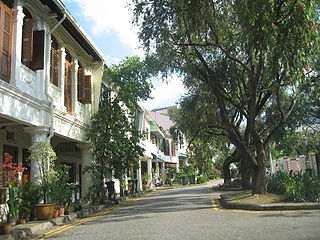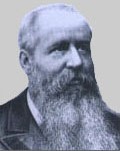Related Research Articles

Prinsep may mean any of several notable members of the British Prinsep family.

Raffles Place is the centre of the Financial District of Singapore and is located south of the mouth of the Singapore River. It was first planned and developed in the 1820s as Commercial Square to serve as the hub of the commercial zone of Singapore in Raffles Town Plan. It was renamed Raffles Place in 1858 and is now the site of a number of major banks. It is located in the Downtown Core within the Central Area, and features some of the tallest buildings and landmarks of the country.

The Jackson Plan or Raffles Town Plan, an urban plan of 1822 titled "Plan of the Town of Singapore", is a proposed scheme for Singapore drawn up to maintain some order in the urban development of the fledgling but thriving colony founded just three years earlier. It was named after Lieutenant Philip Jackson, the colony's engineer and land surveyor tasked to oversee its physical development in accordance with the vision of Stamford Raffles for Singapore, hence it is also commonly called Raffles Town Plan. Raffles gave his instructions in November 1822, the plan was then drawn up in late 1822 or early 1823 and published in 1828. It is the earliest extant plan for the town of Singapore, but not an actual street map of Singapore as it existed in 1822 or 1827 since the plan is an idealised scheme of how Singapore may be organised that was not fully realised. Nevertheless, it served as a guide for the development of Singapore in its early days, and the effect of the general layout of the plan is still observable to this day.

Seah Eu Chin was an immigrant from South China to Singapore, later becoming a successful merchant, a prominent descendant of Seah Clan and leader in the Overseas Chinese community.

Horsburgh Lighthouse is an active lighthouse which marks the eastern entrance to the Straits of Singapore. It is situated on the island of Pedra Branca. Singapore's earliest lighthouse by date of completion, it is located approximately 54 kilometres (34 mi) to the east of Singapore and 14 kilometres (8.7 mi) from the Malaysian state of Johor.

Elgin Bridge is a vehicular box girder bridge across the Singapore River, linking the Downtown Core to the Singapore River Planning Area located within Singapore's Central Area. It was built between 1925 and 1929.

River Valley is a planning area located within the Central Area of the Central Region of Singapore. The planning area shares boundaries with Orchard in the north, Museum in the east, Tanglin in the west, and Singapore River in the south.

Emerald Hill is a neighbourhood and a conservation area located in the planning areas of Newton and Orchard in Singapore. Former home to many members of the city-state's wealthy Peranakan community, it is located near Orchard Road. Many of its homes feature Chinese Baroque architecture. Emerald Hill also the setting for some of the short stories by the late Singaporean author Goh Sin Tub. Many of the homes were designed by Mr R T Rajoo an architect/contractor of those days who died in 1929 at his home in Tank Road, Singapore.

Bras Basah Road is a one-way road in Singapore in the planning areas of Museum and Downtown Core. The road starts at the junction of Orchard Road and Handy Road, at the ERP gantry towards the Central Business District, and ends at the junction with Nicoll Highway, beyond which it becomes Raffles Boulevard. Several landmarks including Fairmont Singapore, Raffles Hotel, Singapore Art Museum, Cathedral of the Good Shepherd and the Singapore Management University are located along the road. A MRT station with the same name, Bras Basah MRT station, is on the Circle Line.
William Henry Macleod Read was an active participant in the commercial, political and social life of Singapore and the Malay states between 1841 and 1887.
John Buttery was a merchant operating in the Straits Settlements of Penang, Malacca and Singapore. He was, at the time of his death, the senior partner of Sandilands, Buttery & Co., and John Buttery & Co..

George Caunter was a British administrator who governed Prince of Wales Island as Acting Superintendent from 1797 to 1798 and again from 1798 to 1800. As First Assistant under Lieutenant-Governor Leith he negotiated the treaty that brought Province Wellesley under British sovereignty in 1800 and that provided, in British eyes, an unequivocal basis for British sovereignty over Penang Island. At various times Caunter further held the offices of marine storekeeper, master attendant, Chief Magistrate, Treasurer and Chaplain in Penang.
William "Royal Billy" Napier (1804–1879), was a Scottish lawyer and newspaper editor who primarily developed his career in Singapore, and was also the first Lieutenant-Governor of Labuan from 1848 to 1850.

Sir John Frederick Dickson was a British colonial administrator in Singapore. He was also President of the Straits Branch of the Royal Asiatic Society from 1886 to 1891. He translated and edited the Upasampadā-kammavācā and the Patimokkha.

William Montgomerie (1797–1856) was a Scottish military doctor with the East India Company, and later head of the medical department at Singapore. He is best known for promoting the use of gutta-percha in Europe. This material was an important natural rubber that made submarine telegraph cables possible. Montgomerie was involved in spice cultivation as head of the Singapore botanical experimental gardens and at his personal estate in Singapore. The latter never became economically viable, but he received a Society of Arts gold medal for nutmeg cultivation. He was also responsible for building the first lunatic asylum in Singapore. Montgomerie died at Barrackpore in India a few years after taking part in the Second Anglo-Burmese War as Superintendent Surgeon.
The Pavilion is a house located at 5 Oxley Rise, Oxley Hill, near Orchard Road in Singapore. The Pavilion served as Government House between 1859 and 1861, after Raffles House was demolished to make way for a fort.

Sampan panjang was a type of Malay fast boat from the 19th century. It was used especially by the sampan-men, or "Orang Laut". Historically, they can be found in Malaysia, Singapore, and Indonesia. This type of boat was used by Malay people as racing boat and as transport boat. The sampan panjang appeared at the first quarter of the 19th century, and disappeared at the turn of that century. These boats proved to be superior than European boats in racing purposes; they were easy winners when racing against the European yachts of that time.
The Bendemeer House, originally known as the House of Whampoa or the Whampoa House, was the former residence of Chinese merchant Hoo Ah Kay in Singapore. The house was demolished in 1964 to make way for redevelopment of the area.

Charles Burton Buckley was a prominent historian, businessman and lawyer in Singapore. He revived The Singapore Free Press in 1884 and wrote An Anecdotal History of Old Times in Singapore.
References
- 1 2 3 Buckley, Charles Burton (1902). An Anecdotal History of Old Times in Singapore. Singapore: Fraser & Neave, Limited. p. 405.
- ↑ Makepeace, W, ed. (1921). One Hundred Years of Singapore. London: CM Turnbull. p. 517.
- ↑ National Heritage Board. Research Report on No. 38 Oxley Road. Singapore: Prime Minister's Office. p. 2.
- ↑ See First Schedule A of the Scheut Missions Ordinance (Chapter 378) which refers to "land comprised in Government Grant No. 2 dated 28th March 1845 and made between East India Co.,... and Thomas Oxley..."
- ↑ Tan, Kevin Y. L. (2015). Of Whales and Dinosaurs: The Story of Singapore's Natural History Museum. Singapore: NUS Press. pp. 9–10.
- ↑ Buckley, Charles Burton (1902). An Anecdotal History of Old Times in Singapore. Singapore: Fraser & Neave. p. 129.